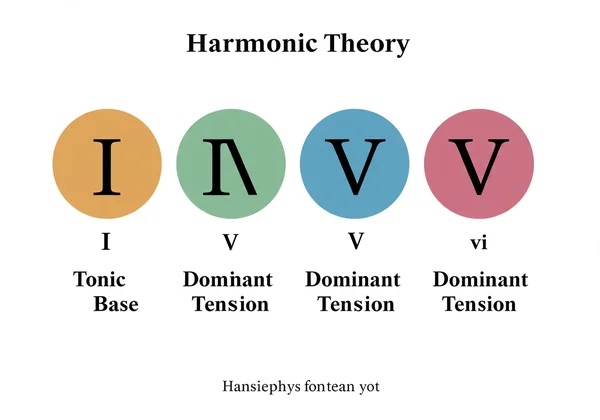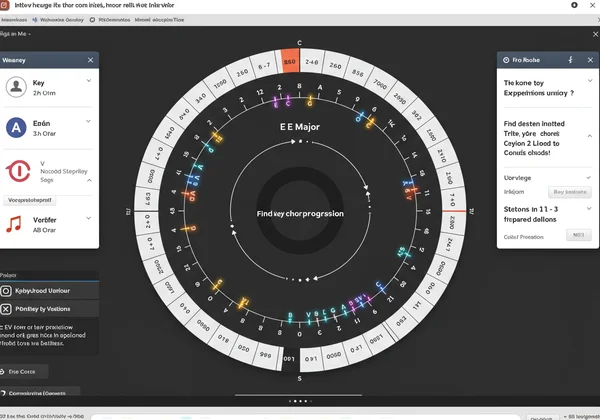Four-Chord Song Secret: Find I-V-vi-IV with Circle of Fifths
Ever wonder why so many hit songs—from pop anthems to heartfelt ballads—sound so good, yet so familiar? The answer often lies in a powerful, yet simple, harmonic trick: the 'four-chord song' progression. But how to use the circle of fifths to unlock this secret for your own music? This guide will demystify the famous I-V-vi-IV progression and show you how to instantly find it in any key using the interactive circle of fifths. With our interactive tool, you can transform your songwriting and playing from confusing to confident.
Unpacking the I-V-vi-IV: Popular Chord Progressions Explained
Before we dive into finding these chords, let's understand why they are the backbone of countless chart-toppers. This progression is more than just a random sequence; it's a story of tension and release that our ears are naturally drawn to. It feels complete, satisfying, and emotionally resonant, making it a favorite for songwriters everywhere.
What Do Roman Numerals Mean in Music Theory?
When musicians talk about chord progressions, you'll often see them use Roman numerals like I, IV, V, and vi. This might seem intimidating, but it's actually a brilliant system that simplifies music theory. Instead of naming specific chords like C Major or G Major, Roman numerals describe a chord's relationship to the "home" note (the tonic) of a particular key.
- I (The Tonic): This is the "home base" chord, built on the first note of the scale. It feels stable and resolved.
- V (The Dominant): Built on the fifth note of the scale, this chord creates the most tension and strongly "pulls" back to the I chord.
- IV (The Subdominant): Built on the fourth note, this chord provides a gentler tension, often feeling like a "pre-dominant" that leads smoothly to the V.
- vi (The Relative Minor): This is a minor chord built on the sixth note of the scale. It adds a touch of emotion, sadness, or reflection to the progression.
Using Roman numerals allows you to talk about a progression's structure regardless of the key you're in. A I-V-vi-IV in C Major is C-G-Am-F, while in G Major it's G-D-Em-C, but they both create the same fundamental emotional journey.

The "Secret Sauce": Why These Four Diatonic Chords Sound So Good Together
The magic of the I-V-vi-IV progression lies in its perfect balance of harmonic function. These are all diatonic chords, meaning they naturally belong to the key you're in. The progression starts at home (I), moves to create strong tension (V), finds an emotional twist (vi), and then builds a gentle ramp back (IV) before resolving.
This cycle of stability (I), tension (V), and emotional color (vi) is a narrative that connects with listeners on a deep level. It’s predictable enough to be catchy but versatile enough to support a huge range of melodies and lyrics. You can find chords instantly and hear this relationship for yourself.
Famous Songs Using the I-V-vi-IV Progression
You have heard this progression thousands of times, even if you didn't know it. It has powered decades of popular music across multiple genres.
Here are just a few examples:
- "Let It Be" by The Beatles
- "Don't Stop Believin'" by Journey
- "I'm Yours" by Jason Mraz
- "Someone Like You" by Adele
- "Take Me Home, Country Roads" by John Denver
Once you learn to recognize its sound, you'll start hearing it everywhere, from rock classics to modern pop hits.

Master the I-V-vi-IV: Using the Circle of Fifths Tool
Now for the fun part. Memorizing the I-V-vi-IV progression in all 12 keys can be a daunting task. But with an interactive tool, you don't have to. The Circle of Fifths is a visual map of musical keys, and our online tool makes it the fastest way to master this progression. Let's walk through it.
Step-by-Step: Finding Your Root Chord (I) on the Circle
First, head over to the CircleOfFifths.io homepage. You'll see the complete Circle of Fifths diagram. Your first step is to choose your key. This will be your "I" chord, or your tonic.
Let's say you want to write a song in the key of E Major. Simply click on "E" on the outer ring of the circle. The tool will instantly highlight the key and show you all the relevant information. Your I chord is E Major.
Discovering the V and IV: Your Closest Harmonic Neighbors
The beauty of the Circle of Fifths is that it arranges keys by their harmonic relationships. The V and IV chords are always the direct neighbors of your I chord on the circle.
- To find the V chord (Dominant): Look one step clockwise from your I chord. For E Major, one step clockwise is B. So, your V chord is B Major.
- To find the IV chord (Subdominant): Look one step counter-clockwise from your I chord. For E Major, one step counter-clockwise is A. Your IV chord is A Major.
Just like that, you have three of your four chords: I (E), V (B), and IV (A). You can explore the Circle of Fifths to see how this works for any key.
Locating the Relative Minor (vi): The Emotional Twist
The final piece of the puzzle is the vi chord. This is the relative minor of your I chord. On our interactive tool, this is incredibly easy to find.
When you select a major key on the outer circle (like E Major), the tool automatically highlights its relative minor on the inner circle. The relative minor of E Major is C# minor. This is your vi chord.
So, in the key of E Major, the I-V-vi-IV progression is: E - B - C#m - A.
Interactive Practice: Find I-V-vi-IV in Any Key with Our Tool!
Ready to try it yourself? Go ahead and experiment. Click on any major key on the outer ring of our tool.
- The key you clicked is your I chord.
- The key one step clockwise is your V chord.
- The key directly inside is your vi chord (it will be minor).
- The key one step counter-clockwise is your IV chord.
With our interactive music theory tool, you can find the four most important chords in any key in seconds. No memorization required.

Songwriting Tips: Elevate Your I-V-vi-IV Progressions
Now that you can find the I-V-vi-IV progression, how do you make it your own? Just because it's common doesn't mean it has to be boring. The magic is in how you use it.
Beyond the Basic Strum: Rhythmic & Melodic Variations
The easiest way to make a common progression sound unique is to change the rhythm and arrangement. Don't just strum four beats per chord.
- Try Arpeggios: Play the notes of the chord one by one instead of all at once. This creates a more delicate and flowing sound.
- Use Syncopation: Change when you switch chords. Try switching on an off-beat to create a more interesting rhythmic feel.
- Vary the Order: While I-V-vi-IV is the classic, try rearranging it! I-vi-IV-V is another popular variation that creates a different emotional arc. Start experimenting now and hear the difference.
Transposing the I-V-vi-IV: Play in Any Key
One of the most crucial skills for a musician is transposing—playing a song in a different key. This is often done to better suit a singer's vocal range. The Circle of Fifths makes this effortless. If a song's I-V-vi-IV progression feels too high or low, simply pick a new starting key on the circle and instantly find the new set of chords. This practical application can help you master music theory in a tangible way.
When to Break the Rules (And How the Circle Still Helps)
The I-V-vi-IV progression is a fantastic starting point, but don't be afraid to experiment. Try substituting one of the chords. For example, instead of the regular IV chord, try a minor iv chord for a more somber feel. The Circle of Fifths can still guide you, showing you other closely related chords that are likely to sound good as substitutions. It's your map for both following the path and exploring off-road.

Unlock Your Songwriting Potential with the Circle of Fifths
The four-chord song secret is out, and it's simpler than you ever imagined. The I-V-vi-IV progression is a powerful tool, and with our interactive Circle of Fifths tool, you have the ultimate key to unlocking it. You no longer need to guess which chords work together or spend hours memorizing patterns.
Now, you can focus on what truly matters: creating melodies, writing lyrics, and expressing yourself through music. Head over to our Circle of Fifths interactive tool and start exploring. Pick a key, find your four chords, and write your next hit song today.
Frequently Asked Questions About the I-V-vi-IV Progression
How can I use the Circle of Fifths to find all chords in a major key?
Our interactive tool makes this simple. When you click on a major key, it not only shows you the I, IV, and V chords (its neighbors) but also the relative minors for each of those. These six chords (I, ii, iii, IV, V, vi) form the core of any major key's harmony. The seventh chord (vii°) is also available in the detailed information provided by our tool.
What is the Circle of Fifths used for in modern songwriting?
In modern songwriting, the Circle of Fifths is a quick-reference tool for creativity and problem-solving. It's used to find natural-sounding chord progressions, create interesting modulations (key changes), transpose songs for different singers, and find chords that work for a given melody. It's less of a rigid rulebook and more of a creative map.
Can the I-V-vi-IV progression be used in any musical genre?
Absolutely. While it's most famous in pop and rock, its fundamental harmonic strength makes it adaptable. In country music, it provides a feeling of home and heart. In R&B, it can be a smooth foundation for complex vocal melodies. In folk music, it's perfect for storytelling. The style comes from the rhythm, instrumentation, and melody you place on top of it.
How do I find the relative minor (vi) chord using the Circle of Fifths?
The relative minor (the 'vi' chord in the I-V-vi-IV) of any major key is located directly on the inner circle of the diagram. On your music theory companion, when you select a major key on the outer ring, its relative minor is automatically highlighted on the inner ring, making it impossible to miss. For example, C Major's relative minor is A minor.